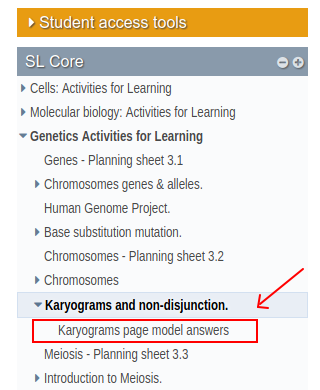Karyograms and non-disjunction
 In three short activities student explore how non-disjunction can lead to changes in chromosome number. This is illustrated by reference to Down syndrome (trisomy 21). Students will watch a six minute video clip, complete a powerpoint karyotype activity and then analyse several karyotypes using a worksheet. To finish there is a review sheet containing some IB style questions.
In three short activities student explore how non-disjunction can lead to changes in chromosome number. This is illustrated by reference to Down syndrome (trisomy 21). Students will watch a six minute video clip, complete a powerpoint karyotype activity and then analyse several karyotypes using a worksheet. To finish there is a review sheet containing some IB style questions.
Lesson Description
![]() Guiding Questions
Guiding Questions
What does a full set of human chromosomes look like:
- In a cell?
- During cell division?
- On a karyogram?
Why are chromosomes arranged in pairs in a karyogram?
(click the image to enlarge)
Activity 1 - A basic Karyogram of a karyotype
Look at the slides on this powerpoint ![]() Karyogram drag & drop powerpoint and complete the drag and drop exercise to understand the basic structure of chromosomes and how karyograms are drawn.
Karyogram drag & drop powerpoint and complete the drag and drop exercise to understand the basic structure of chromosomes and how karyograms are drawn.
(Download a copy using the drop-down menu in the bottom right corner)
Activity 2 - Chromosome Non-disjunction - when meiosis goes wrong.
This Youtube clip is 6 minutes and illustrates clearly what happens in non-disjunction to cause trisomy 21.
Complete these ![]() Non-disjunction summary questions
Non-disjunction summary questions
Activity 3 Analysis of Karyotypes Activity
Complete the short activity on the ![]() Analysis of human karyotype activity below.
Analysis of human karyotype activity below.
If you have time do the Extra Reading: ![]() Online Karyotyping Activity including analysis of karyotypes
Online Karyotyping Activity including analysis of karyotypes
Activity 4 - Review questions on Meiosis - prepare for next lesson
Complete the short activity on the ![]() Meiosis revision worksheet below
Meiosis revision worksheet below
Teachers notes
This lesson introduces the basic ideas of non-disjunction and karyotyping.
There are four sections which are clearly outlined above.
Activity 1 introduces the karyotype and some of its applications.
Activity 2 demonstrates the consequences of non-disjunction.
Activity 3 gives students some practice on the analysis of karyotypes.
Activity 4 Includes are a couple of extension activities which introduce students to some of the concepts of meiosis.
There are model answers on this page: Karyograms page model answers
This page is also accessed using the left hand menu - you will have to scroll up.
A good to end this lesson could involve this Nice video showing the lab process for preparing slides for karyotype analysis if time allows. It gives students an insight into the work of a biologist in a hospital lab.
Alternatively this Video of ![]() Ten things people with Down syndrome would like you to know helps give students more knowledge of the human side of Downs syndrome, it could lead to CAS activities.
Ten things people with Down syndrome would like you to know helps give students more knowledge of the human side of Downs syndrome, it could lead to CAS activities.
Resources that were considered for this activity but which didn't make it into the plan.
- Youtube video explanation of non-disjunction
 Karyogram analysis activity
Karyogram analysis activity Revision activity for Meiosis and Karyotypes
Revision activity for Meiosis and Karyotypes- Online Karyotype Activity including analysis of karyograms
 Nice video showing the lab process for preparing slides
Nice video showing the lab process for preparing slides- Summary Worksheet of Meiosis, crossing over and karyotypes (inc. pp qns)

 IB Docs (2) Team
IB Docs (2) Team
